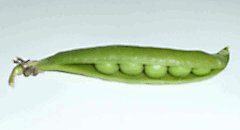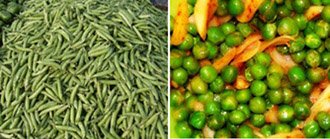Green Peas Nutrition Facts
Sweet, delicious green peas, also popularly known as garden peas, are one of the ancient cultivated vegetables grown for their delicious, nutritious green seeds. Peas probably originated in the sub-Himalayan plains of northwest India. Today, this versatile legume is one of the major commercial crops grown all over temperate and semi-tropical regions.
Botanically, the pea plant is a herbaceous vine. It belongs to the family Fabaceae, in the genus Pisum. Scientific name: Pisum sativum. Some of the common names include English peas, spring peas, sweet peas, garden peas, pease, etc.

|
| Green pea. Note bright green pod encasing around light-green edible peas. |
Pea is a quick-growing, annual herbaceous vine that requires a trellis to support its growth. It flourishes in well-drained, sandy soil supplemented with adequate moisture and cold weather conditions. Short-stalked, green pods appear by late winter or early spring. Each pod measures about 2-3 inches long, swollen or compressed, straight or slightly curved, and is filled with a single row of 2-10 light-green, smooth edible seeds.
In general, the pods are harvested while just short of reaching maturity, at the point when their seeds are green, soft, sweet, and edible raw. Allowing the pods to mature further would turn the seeds dry, light-green to yellow, less sweet, and bitter to taste.
 |
| Garden pea vine with pods. |
Pea shoots are also edible delicacies. They are delicate, tender top shoots of a young pea plant. Pea tendrils have a flavor akin to peas. Pea tendrils and leafy shoots are some of the favored items in salads and cooking in many East and Southeast Asian regions.
Snow peas or sugar snap peas are different species of peas wherein the whole immature green pod, including its outer peel, can be eaten as a vegetable.
Health Benefits of Green Peas
Green peas are one of the most nutritious leguminous vegetables, rich in health-promoting phytonutrients, minerals, vitamins, and antioxidants.
Fresh, tender peas are relatively low in calories compared to beans and cowpeas. 100 g of green peas contain just 81 calories and no cholesterol. Nonetheless, they are good sources of protein, vitamins, and soluble as well as insoluble fiber.
Fresh pea pods are excellent sources of folic acid. 100 g provides 65 µg or 16% of the recommended daily levels of folates.
Folates are one of the B-complex vitamins required for DNA synthesis inside the cell. Studies suggest that adequate consumption of folate-rich foods by expectant mothers can help prevent neural tube defects in newborn babies.
Fresh green peas are healthy sources of ascorbic acid (vitamin C). 100 g of fresh pods contain 40 mg or 67% of the daily requirement of vitamin C. Vitamin C is a powerful natural water-soluble antioxidant.
Vegetables rich in this vitamin can help the human body develop resistance against infectious agents and scavenge harmful, pro-inflammatory free radicals from the body.
Peas contain phytosterols, especially ß-sitosterol. Studies suggest that vegetables like legumes, fruits, and cereals rich in plant sterols can help lower cholesterol levels in the human body.
Garden peas are also good sources of vitamin K. 100 g of fresh seeds contain about 24.8 µg or about 21% of the daily requirement of vitamin K-1 (phylloquinone).
Vitamin K has been found to have a potential role in bone mass-building function (mineralization) through the promotion of osteoblastic activity inside the bone cells. It also has an established role in the treatment of Alzheimer's disease patients by limiting neuronal damage in the brain.
Fresh green peas also contain adequate amounts of antioxidants and flavonoids such as carotenes, lutein, and zeaxanthin, as well as vitamin A (providing 765 IU or 25.5% of RDA per 100 g). Vitamin A is an essential nutrient required for maintaining healthy membranes, skin, and eyesight. Additionally, consumption of natural fruits/vegetables rich in flavonoids helps protect against lung and oral cavity cancers.
Peas are also rich in many other essential B-complex vitamins such as pantothenic acid, niacin, thiamin, and pyridoxine. Furthermore, they are a rich source of many minerals such as calcium, iron, copper, zinc, and manganese.
| Principle | Nutrient Value | Percent of RDA |
|---|---|---|
| Energy | 81 Kcal | 4% |
| Carbohydrates | 14.45 g | 11% |
| Protein | 5.42 g | 10% |
| Total Fat | 0.40 g | 2% |
| Cholesterol | 0 mg | 0% |
| Dietary Fiber | 5.1 g | 13% |
| Vitamins | ||
| Folates | 65 µg | 16% |
| Niacin | 2.090 mg | 13% |
| Pantothenic acid | 0.104 mg | 2% |
| Pyridoxine | 0.169 mg | 13% |
| Riboflavin | 0.132 mg | 10% |
| Thiamin | 0.266 mg | 22% |
| Vitamin A | 765 IU | 25.5% |
| Vitamin C | 40 mg | 67% |
| Vitamin E | 0.13 mg | 1% |
| Vitamin K | 24.8 µg | 21% |
| Electrolytes | ||
| Sodium | 5 mg | <1% |
| Potassium | 244 mg | 5% |
| Minerals | ||
| Calcium | 25 mg | 2.5% |
| Copper | 0.176 mg | 20% |
| Iron | 1.47 mg | 18% |
| Magnesium | 33 mg | 8% |
| Manganese | 0.410 mg | 18% |
| Selenium | 1.8 µg | 3% |
| Zinc | 1.24 mg | 11% |
| Phyto-nutrients | ||
| Carotene-ß | 449 µg | -- |
| Crypto-xanthin-ß | 0 µg | -- |
| Lutein-zeaxanthin | 2477 µg | -- |
Selection and Storage
Green peas are winter crops. Fresh peas are readily available from December until April in farmer's markets. However, cold-stored packs, dry peas, mature seeds, split peas, flour, etc., can be found in groceries year-round.
When shopping for green peas, look for fresh pods that are full, heavy, and brimming with seeds. Avoid those with wrinkled skin or over-mature yellow pods.
Green peas are at their best soon after harvest, as much of their sugar content rapidly converts into starch. To store them, place them inside a vegetable container in the home refrigerator set at high relative humidity, where they will stay fresh for 2-3 days. Frozen seeds, however, can be used for several months.
Preparation and serving methods
 |
| Green peas in a market and sauteed peas in oil, garlic, and onion. |
Trim away the stalk end and peel the thin thread along the suture line. Then, split open the outer husk to release round to oval, green seeds.
Here are some serving tips:
Peas mix well with other complementing vegetables like potato, carrot, beets, onion, artichokes, etc., in the preparation of a wide variety of dishes.
Peas can be added to soup as a flavorful side dish.
Green peas, known as mutter (मटर), are one of the common ingredients in winter season delicacies in the Indian subcontinent. Fresh peas are added to a variety of mouth-watering recipes like Aaloo-mutter (आलू मटर), mutter-paneer, mutter-gajjar, etc., with added spices, garlic, coriander leaves, onions, and tomato.
Safety Profile
Green peas are generally safe to eat for all individuals. They contain negligible amounts of oxalic acid, approximately 1 mg per1/2 cup, a naturally occurring substance found in some vegetables. In some people, oxalic acid may crystallize as oxalate stones in the urinary tract. For comparison, Navy Beans hold 76 mg of oxalic acid per 1/2 cup. Adequate intake of water is, therefore, encouraged to maintain normal urine output and minimize the risk of stone formation. (Medical disclaimer)
Also read ≻≻-
≻≻- Pea Shoots nutrition facts and health benefits.
≻≻- Sugar Snap Peas nutrition facts and health benefits.
≻≻- Snow Peas nutrition facts and health benefits.
≻≻-Back to Vegetables from Green peas. Visit here for an impressive list of vegetables with complete illustrations of their nutrition facts and health benefits.
≻≻-Back to Home page.
Further reading:
Refer Stanford School of Medicine Cancer information Page- Nutrition to Reduce Cancer Risk (Link opens in new window).
Pisum sativum University of Maryland Extension. (Link opens in new window).